Green, green
 Back from over a month in England and Wales, I ask myself what those weeks of garden visiting mean. Or do they have to mean? I certainly felt at home living amid a garden culture with far more breadth and depth than our's in the U.S., regardless of superficiality and tradition-bound conservatism I was made aware of from time to time, and I'm trying to resist a temptation to compare and judge the gardens I saw, unsuccessfully as you will see. What is this impulse to rank and group experiences as if they were commodities?
Back from over a month in England and Wales, I ask myself what those weeks of garden visiting mean. Or do they have to mean? I certainly felt at home living amid a garden culture with far more breadth and depth than our's in the U.S., regardless of superficiality and tradition-bound conservatism I was made aware of from time to time, and I'm trying to resist a temptation to compare and judge the gardens I saw, unsuccessfully as you will see. What is this impulse to rank and group experiences as if they were commodities?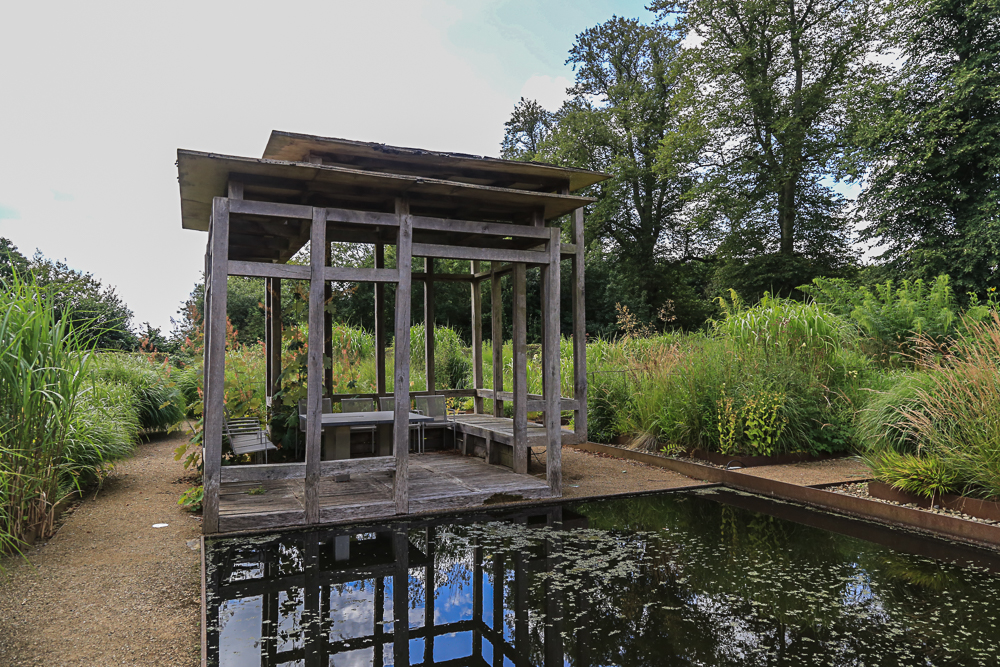 Visiting Bury Court, where John Coke has the pleasure (and perhaps burden) of having two significant gardens in one--on one side of the house Piet Oudolf's first garden designed in the UK and on the other a superficially similar garden by Christopher Bradley-Hole--clarified some of my own preferences, quite unexpectedly. I preferred the Bradley-Hole garden. Though I don't think it necessary to choose favorites, and I'm a long time admirer of Piet Oudolf's work, my immediate realization that I had a definite preference was both unexpected and a surprise. So why?
Visiting Bury Court, where John Coke has the pleasure (and perhaps burden) of having two significant gardens in one--on one side of the house Piet Oudolf's first garden designed in the UK and on the other a superficially similar garden by Christopher Bradley-Hole--clarified some of my own preferences, quite unexpectedly. I preferred the Bradley-Hole garden. Though I don't think it necessary to choose favorites, and I'm a long time admirer of Piet Oudolf's work, my immediate realization that I had a definite preference was both unexpected and a surprise. So why?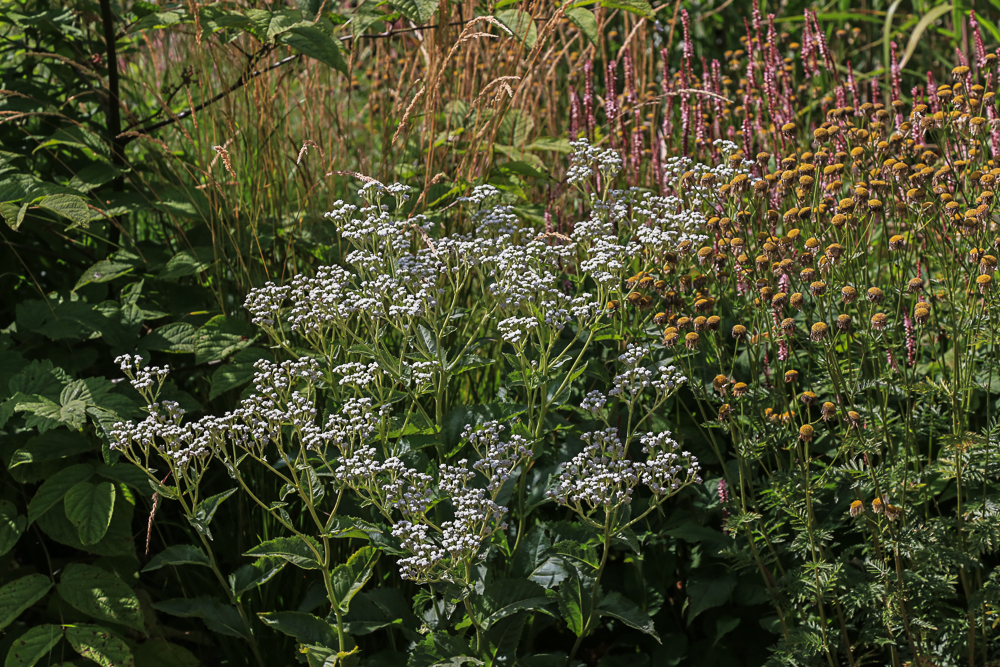 First the Oudolf garden, briefly. After being gripped by, and finally throwing off, an initial feeling of something like "reverence" I usually experience on first seeing gardens I've long known only through books and magazines, I immensely admired the Oudolf garden for itself, though it's been changed over the almost twenty years of its existence in ways I don't know. I was especially impressed with the now "archetypal" Deschampsia meadow that has been widely imitated.
First the Oudolf garden, briefly. After being gripped by, and finally throwing off, an initial feeling of something like "reverence" I usually experience on first seeing gardens I've long known only through books and magazines, I immensely admired the Oudolf garden for itself, though it's been changed over the almost twenty years of its existence in ways I don't know. I was especially impressed with the now "archetypal" Deschampsia meadow that has been widely imitated.
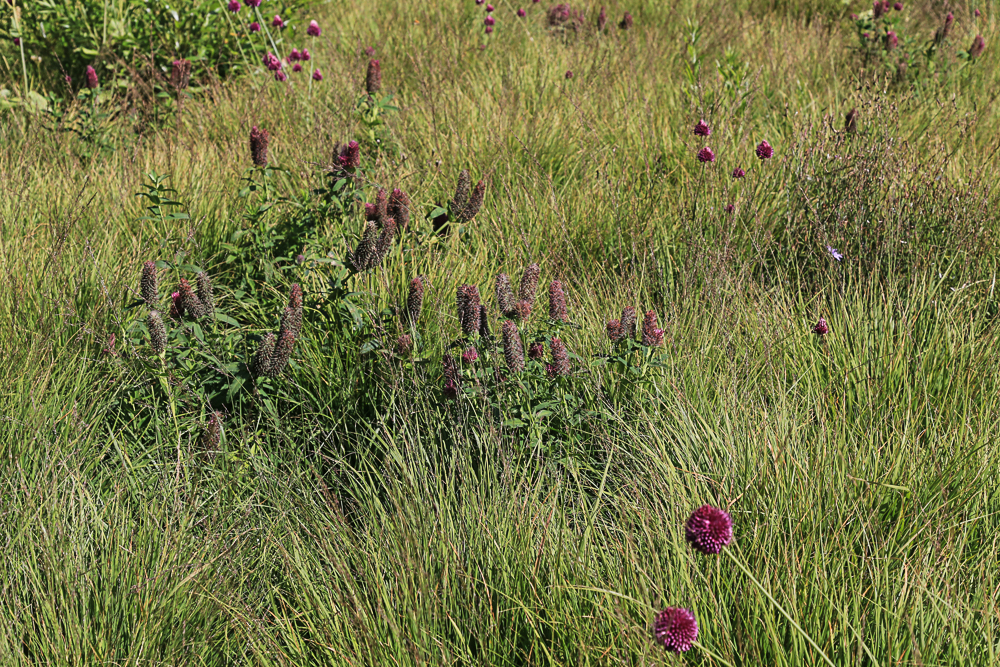 The garden is quite small compared to the much more expansive gardens we now expect from Piet Oudolf, though its enclosure in a courtyard had the benefit of imposing a structure lacking in the far larger and perhaps more ambitious garden at the Hauser & Wirth gallery in Somerset, which we had seen just the day before, and which I felt lacked sufficient structure to satisfy my need for focus (perhaps a premature judgment considering the early state of that garden's development; more on that in another post).
The garden is quite small compared to the much more expansive gardens we now expect from Piet Oudolf, though its enclosure in a courtyard had the benefit of imposing a structure lacking in the far larger and perhaps more ambitious garden at the Hauser & Wirth gallery in Somerset, which we had seen just the day before, and which I felt lacked sufficient structure to satisfy my need for focus (perhaps a premature judgment considering the early state of that garden's development; more on that in another post).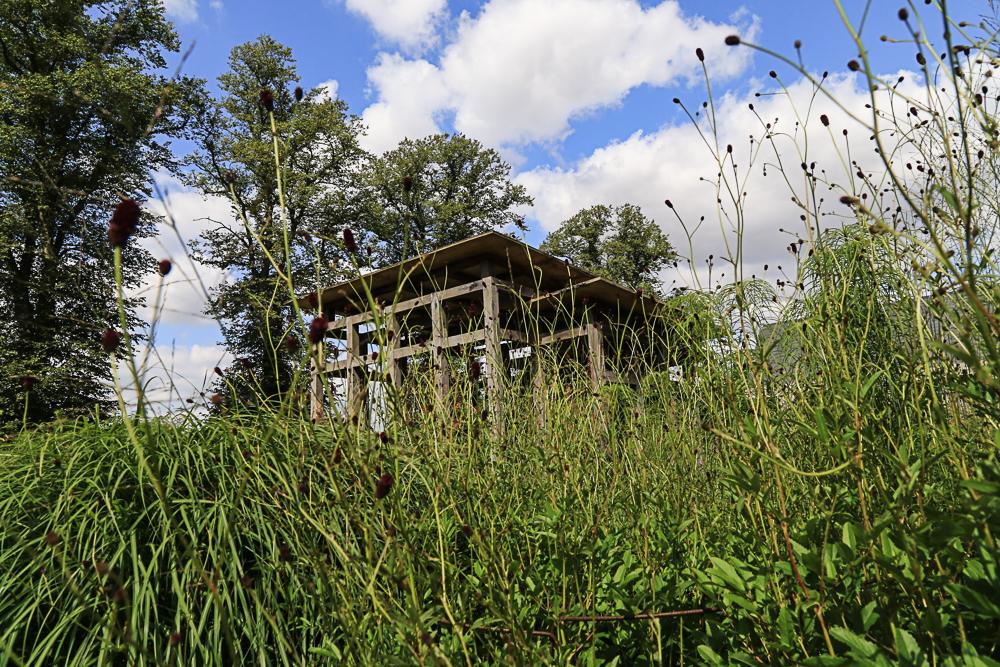 John Coke unexpectedly came out as we were about to move on to the Christopher Bradley-Hole garden on the other side of the building. I hadn't expected to see him, and was very happy that he chose to walk with us to the Bradley-Hole garden and stay for the remainder of our visit. I had recently read the Noel Kingsbury's reconstruction of the history of the New Perennials movement in his and Oudolf's new book, Hummelo, where I'd learned John had a significant role in the development of this garden design movement that has been so close to my heart. I wish I'd asked more about that, but I limited myself to practical questions of plant identification and his own feelings about the garden.
John Coke unexpectedly came out as we were about to move on to the Christopher Bradley-Hole garden on the other side of the building. I hadn't expected to see him, and was very happy that he chose to walk with us to the Bradley-Hole garden and stay for the remainder of our visit. I had recently read the Noel Kingsbury's reconstruction of the history of the New Perennials movement in his and Oudolf's new book, Hummelo, where I'd learned John had a significant role in the development of this garden design movement that has been so close to my heart. I wish I'd asked more about that, but I limited myself to practical questions of plant identification and his own feelings about the garden. I've admired this garden, again only in photos, for years, but I was unprepared to be so powerfully affected when I first walked into it. It was like passing into another dimension, certainly a very different place--a place of transcendent greenness, green wildness anchored in a rigid, almost hidden (at this time of year) structure of 20 Corten steel squares. I felt the space suddenly open up and welcome me, envelope me. The garden is intensely immersive, though it works with such a light, airy touch it's not at all claustrophobic or oppressive. The transition from the Oudolf garden, beautiful as it is, to the utter simplicity of this green, immersive garden was a minor shock to the nervous system, but one of unalloyed pleasure.
I've admired this garden, again only in photos, for years, but I was unprepared to be so powerfully affected when I first walked into it. It was like passing into another dimension, certainly a very different place--a place of transcendent greenness, green wildness anchored in a rigid, almost hidden (at this time of year) structure of 20 Corten steel squares. I felt the space suddenly open up and welcome me, envelope me. The garden is intensely immersive, though it works with such a light, airy touch it's not at all claustrophobic or oppressive. The transition from the Oudolf garden, beautiful as it is, to the utter simplicity of this green, immersive garden was a minor shock to the nervous system, but one of unalloyed pleasure.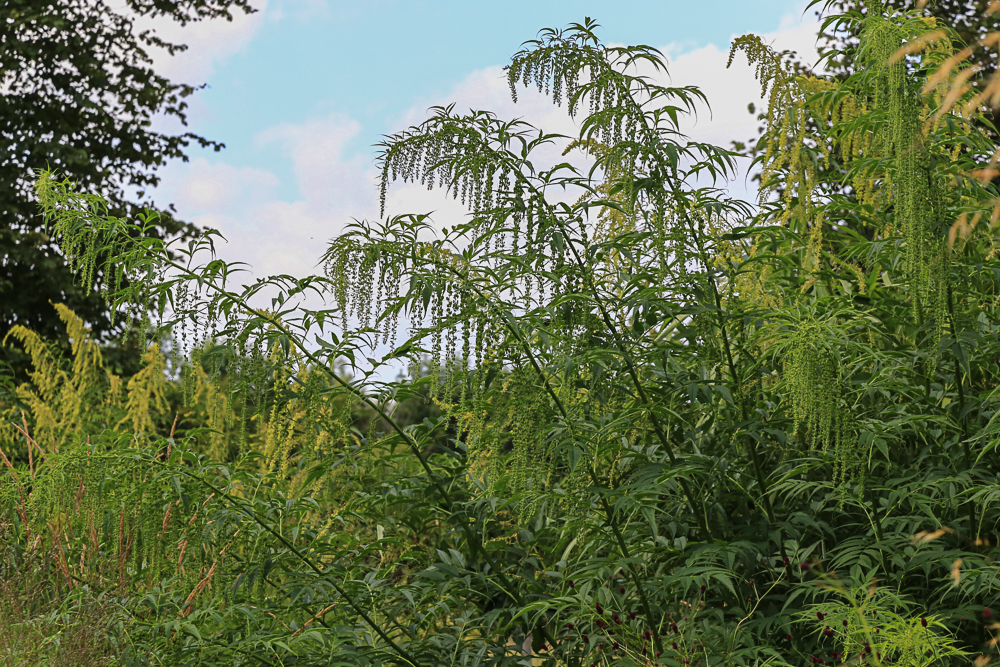 So why did I feel a preference (most definitely it was an emotionally led preference, not an intellectual one) for the Bradley-Hole garden? Probably because it strongly reminded me of my own garden, I have to admit, though vastly different.
So why did I feel a preference (most definitely it was an emotionally led preference, not an intellectual one) for the Bradley-Hole garden? Probably because it strongly reminded me of my own garden, I have to admit, though vastly different.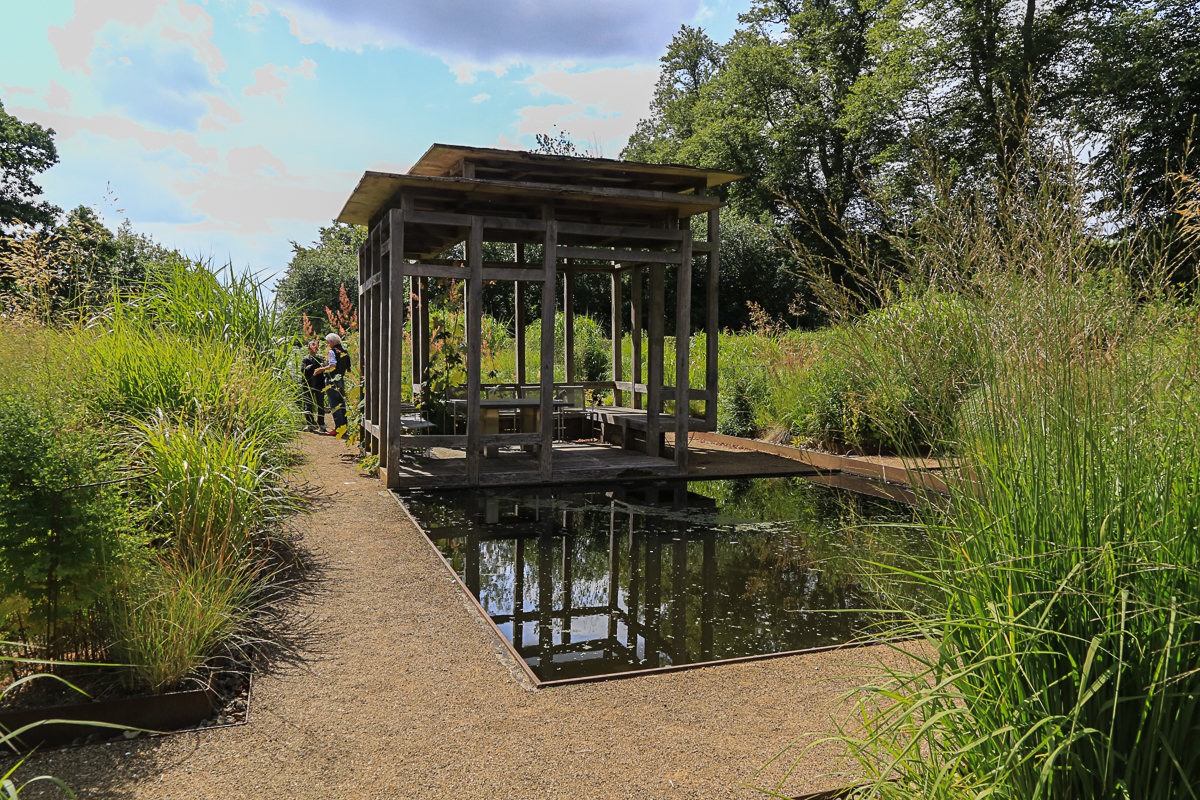 The central pavilion and pool create a dramatic contrast with the loose plantings and are critical to the garden's effect. The space required for these central features is relatively long and large, and suggests, at least to me, the paradise garden of the Persians, an emotional resonance that further confirmed my preference for this garden. The linearity and openness of this part of the garden makes it possible to see a bit more of the structure of the formal grid of steel squares that anchor the garden into the highly structured gravel matrix. Within this open center, you can see, or easily imagine, vanishing points that suggest the enclosed linearity of a paradise garden, and the pool, the water so typical of such gardens. So, for me, a paradise garden in southern England in the 21st century ...
The central pavilion and pool create a dramatic contrast with the loose plantings and are critical to the garden's effect. The space required for these central features is relatively long and large, and suggests, at least to me, the paradise garden of the Persians, an emotional resonance that further confirmed my preference for this garden. The linearity and openness of this part of the garden makes it possible to see a bit more of the structure of the formal grid of steel squares that anchor the garden into the highly structured gravel matrix. Within this open center, you can see, or easily imagine, vanishing points that suggest the enclosed linearity of a paradise garden, and the pool, the water so typical of such gardens. So, for me, a paradise garden in southern England in the 21st century ... ... respite, restoration, un dolce ristoro.
... respite, restoration, un dolce ristoro.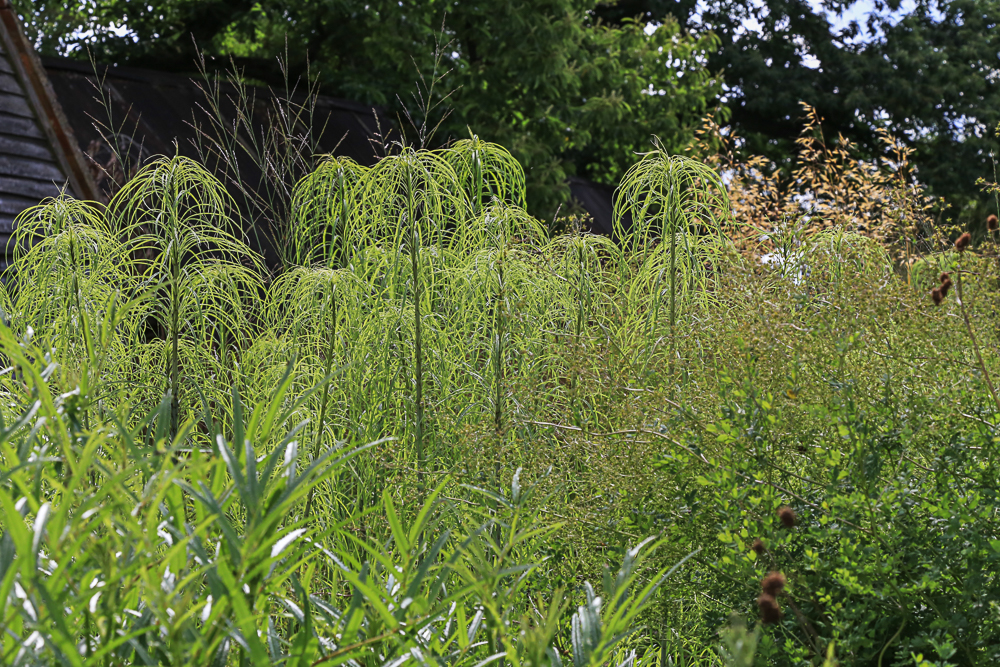 Mostly green, the garden works through simplicity and repetition of shapes.
Mostly green, the garden works through simplicity and repetition of shapes.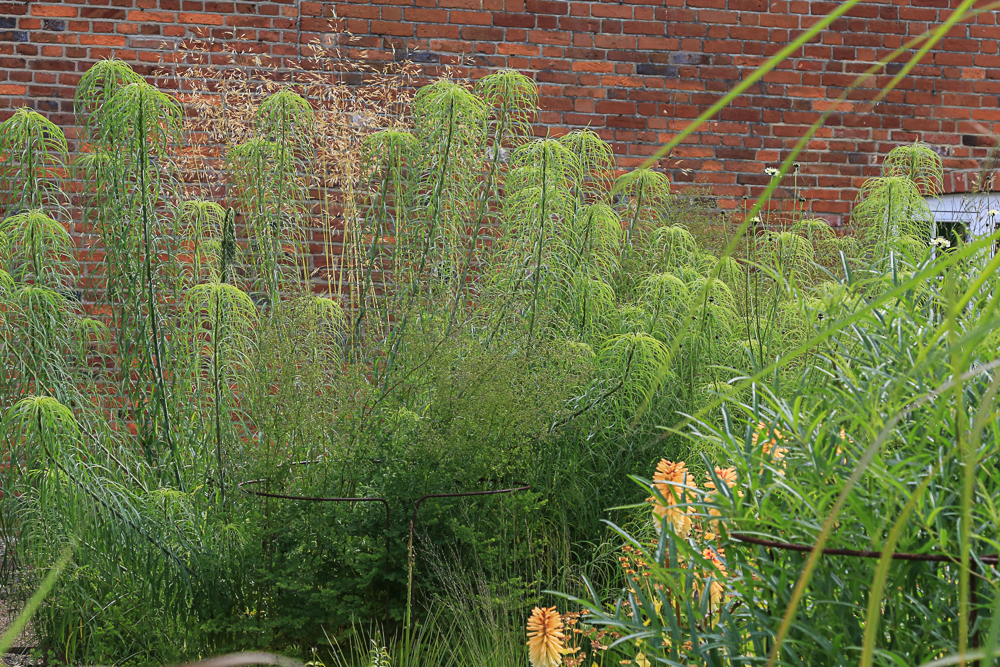 Structural plants with distinctive forms, such as the Helianthus salicifolius (above), liberal use of Datisca cannabina, Miscanthus giganteus, Macleaya, Persicaria polymorpha, bobble-headed Sanguisorbas, Stipa gigantea, Molinia, Panicums, various other grasses and some perennials provide visual interest within a unified field of tranquil green. I can only imagine how colorful this garden must be in autumn; you can see a glimpse of it in this Stephen Lacy piece in the Telegraph.
Structural plants with distinctive forms, such as the Helianthus salicifolius (above), liberal use of Datisca cannabina, Miscanthus giganteus, Macleaya, Persicaria polymorpha, bobble-headed Sanguisorbas, Stipa gigantea, Molinia, Panicums, various other grasses and some perennials provide visual interest within a unified field of tranquil green. I can only imagine how colorful this garden must be in autumn; you can see a glimpse of it in this Stephen Lacy piece in the Telegraph.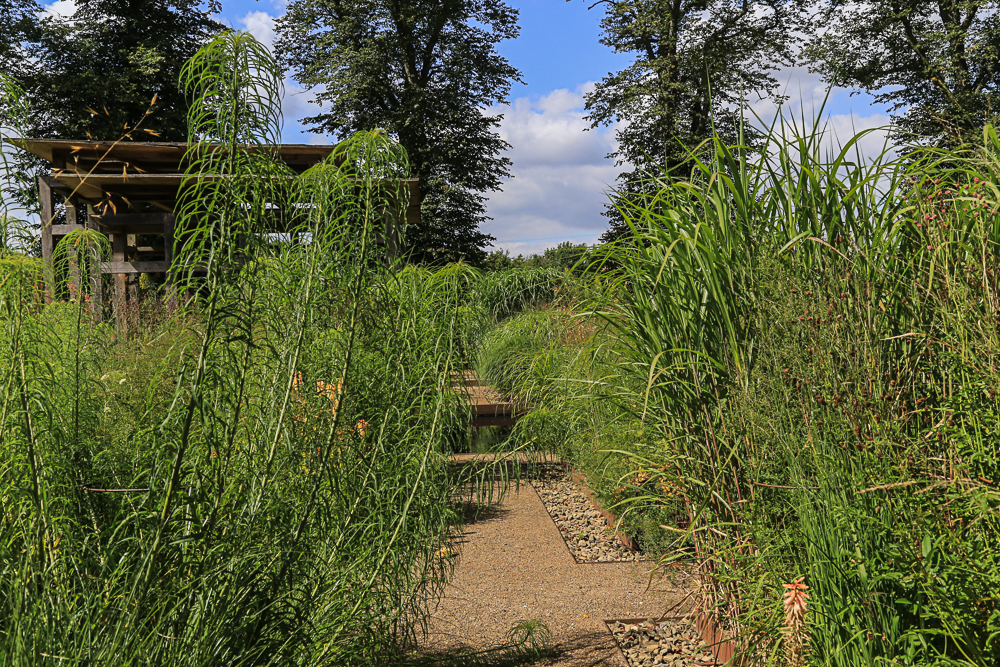 Though the garden is relatively small, the plants are overscaled to create a sense of enclosure and protection, refuge and prospect, but an illusory refuge of thin veils of vegetation. The big sky and the see-through quality of the plantings prevent any sense of claustrophobia. The formal structure of the garden, too, allows glimpses out (where the plants haven't blocked or fallen across the view corridors, a natural and desirable occurrance).
Though the garden is relatively small, the plants are overscaled to create a sense of enclosure and protection, refuge and prospect, but an illusory refuge of thin veils of vegetation. The big sky and the see-through quality of the plantings prevent any sense of claustrophobia. The formal structure of the garden, too, allows glimpses out (where the plants haven't blocked or fallen across the view corridors, a natural and desirable occurrance).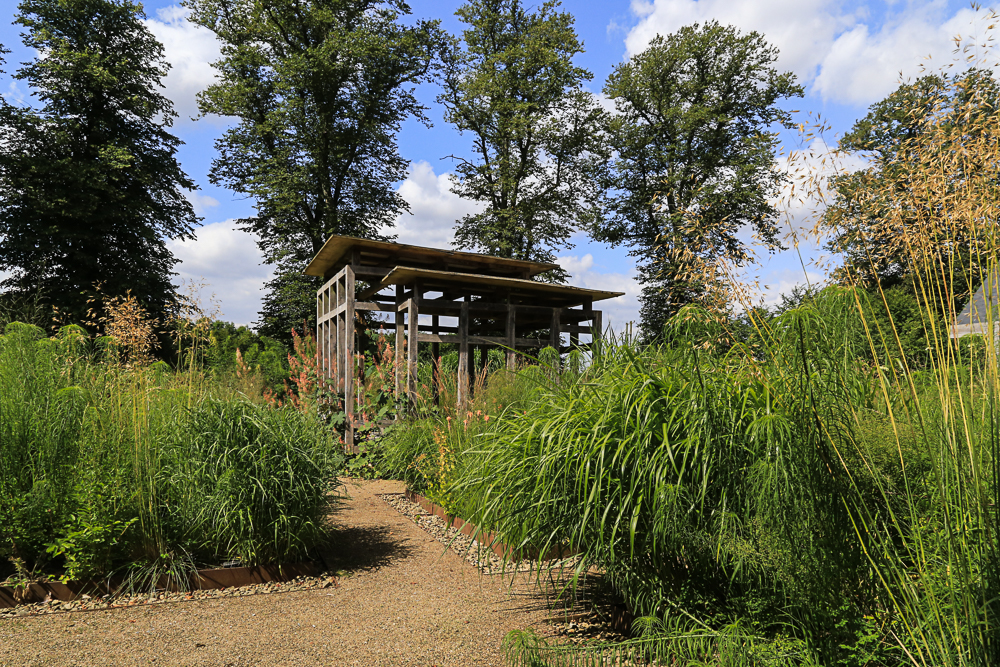 The garden invites the viewer's eye to enter in a specific way. First, you see the setting, the sky and natural fields and woodlands surrounding it, and which the garden imitates in a more structured way. Then the pavilion attracts attention with its tall, hard structure, and invites contemplation of the complexity of that structure, consisting of two-interlocking cubes slightly offset vertically and horizontally. The pavilion's structure can work subconsciously or consciously to create the idea of movement, a kind of metaphorical stepping aside, perhaps suggesting dance, and this is picked up by the plantings, both in the ground rhythm of the squares within squares, and more loosely, by the dance and swirl of the grasses and perennials, which even when still, also suggest movement.
The garden invites the viewer's eye to enter in a specific way. First, you see the setting, the sky and natural fields and woodlands surrounding it, and which the garden imitates in a more structured way. Then the pavilion attracts attention with its tall, hard structure, and invites contemplation of the complexity of that structure, consisting of two-interlocking cubes slightly offset vertically and horizontally. The pavilion's structure can work subconsciously or consciously to create the idea of movement, a kind of metaphorical stepping aside, perhaps suggesting dance, and this is picked up by the plantings, both in the ground rhythm of the squares within squares, and more loosely, by the dance and swirl of the grasses and perennials, which even when still, also suggest movement.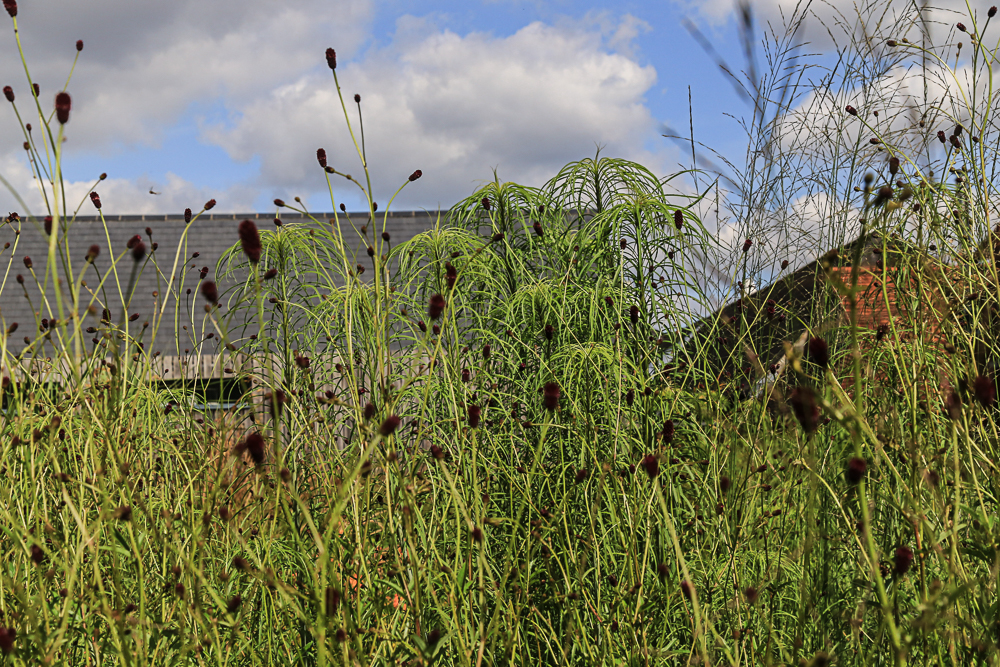 As I write this, I'm sitting in my living room looking out a wall of windows. The morning is unusually cool for this season, about 68 degrees, with a light breeze, and outside the view of the garden is blocked by a brightly lit scrim of miscanthus in flowery plume and greenish yellow Patrinia scabiosifolia. Sunlight glints off the miscanthus foliage, almost blinding in its brightness. This scrim, only twelve feet or so from the house, is echoed by the tall woods on the far side of the garden. Sunlight pours into the woods making an abstract chiaroscuro of dark trunks and bright green going deep into the trees, like some magical, extremely complicated lantern no human would ever think to try to invent. These two shapes, the scrim of miscanthus and Patrinia, and the looming hump of woods, make the main garden down below totally invisible. The beatific buzz of cicadas rises and falls in a calm, meditative rhythm. All of this brings the Bradley-Hole garden back to mind--the interplay of large grasses, especially miscanthus, with the sunlight streaming lavishly down, the gentle, random movements of the plants, the tranquility.It's good to be home.
As I write this, I'm sitting in my living room looking out a wall of windows. The morning is unusually cool for this season, about 68 degrees, with a light breeze, and outside the view of the garden is blocked by a brightly lit scrim of miscanthus in flowery plume and greenish yellow Patrinia scabiosifolia. Sunlight glints off the miscanthus foliage, almost blinding in its brightness. This scrim, only twelve feet or so from the house, is echoed by the tall woods on the far side of the garden. Sunlight pours into the woods making an abstract chiaroscuro of dark trunks and bright green going deep into the trees, like some magical, extremely complicated lantern no human would ever think to try to invent. These two shapes, the scrim of miscanthus and Patrinia, and the looming hump of woods, make the main garden down below totally invisible. The beatific buzz of cicadas rises and falls in a calm, meditative rhythm. All of this brings the Bradley-Hole garden back to mind--the interplay of large grasses, especially miscanthus, with the sunlight streaming lavishly down, the gentle, random movements of the plants, the tranquility.It's good to be home.